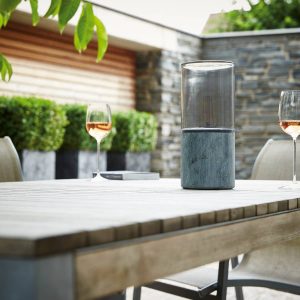Lighting designers and architects are faced with the special challenge of integrating light not only functionally. Light is a design element that is an important addition to the overall concept. It is not just a question of its effect in the room, the mood it creates or the function it must fulfil. The light source itself must also fit seamlessly into the outdoor area.
Classic shapes such as lanterns or simple bollards are far from being obsolete here. They have something original and historic about them – and, depending on the material and design, take you back to a long time ago when fire still burned in their midst instead of LEDs.
Today, however, the return to the original is no longer only reflected in the shape and colour of the lamps. Today, the trend is clearly towards unusual and, above all, natural materials. This starts with the look and ends with the “building material” of the lamp body.
Heavy materials such as stone or concrete can be found here, but also filigree glass in a completely new look. In any case, however, materials that belong naturally in nature and the garden.
What could be more pristine than basalt stone? The heavy material that literally sprouts directly from the earth stands for an inimitable divergence. The destructive power of magma is contrasted by the creative power of its solid form – basalt. This is the only way basalt could become the most widespread rock in the world: on land as well as underwater – in some cases even further. Because basalt rock is also found on the Moon and Mars and other terrestrial planets. With the SLV LISENNE lamp family, you can now bring the original rock into the garden and outdoor area. Basalt stone forms the solid base of the outdoor lamps.

The SLV ARROCK series is an equally extraordinary combination. In a modern look, natural stone together with stainless steel form an extraordinary pair. The angular design emphasises the solid character of the stone and the indirect light also plays its part.
2 thoughts on “Back to Nature: Lamps made from natural materials”
Comments are closed.